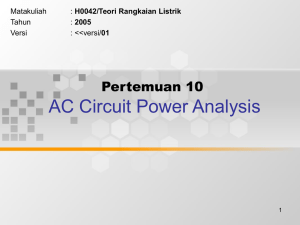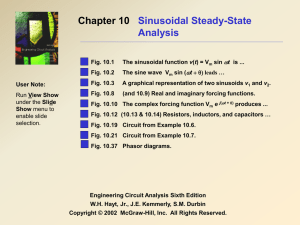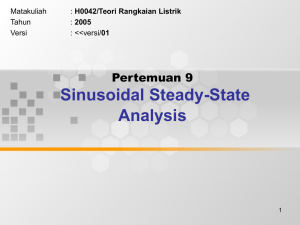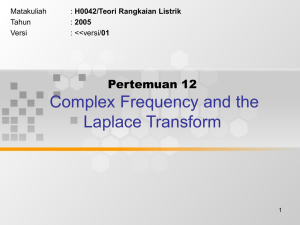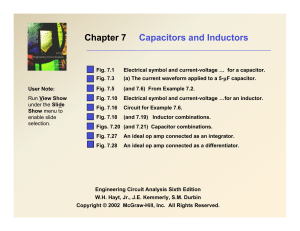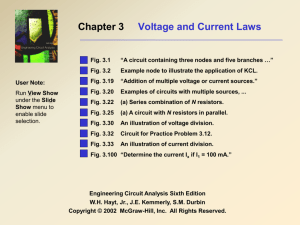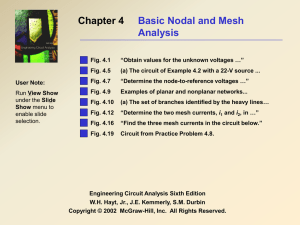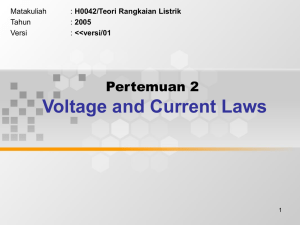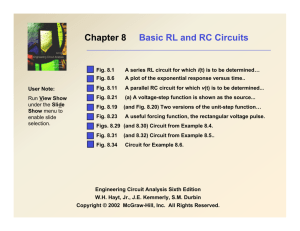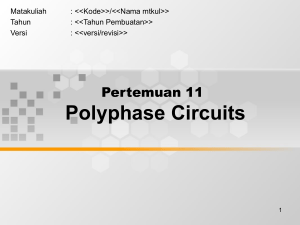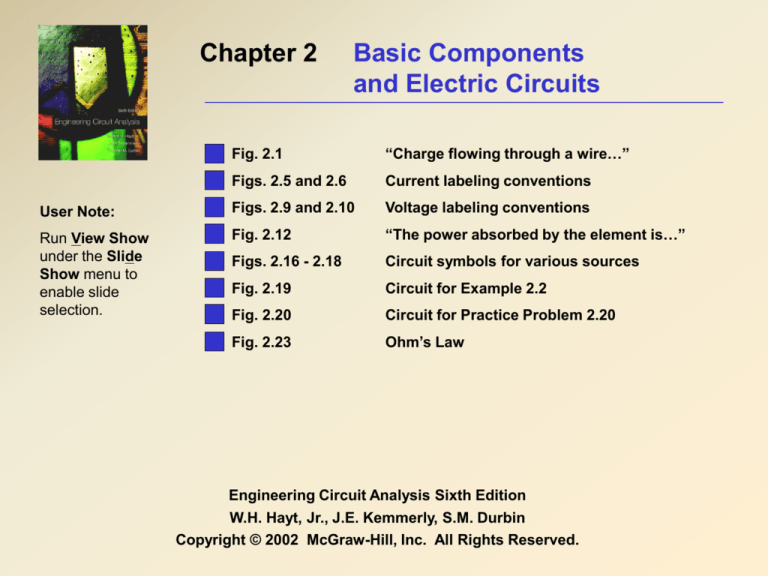
Chapter 2
Basic Components
and Electric Circuits
Fig. 2.1
“Charge flowing through a wire…”
Figs. 2.5 and 2.6
Current labeling conventions
User Note:
Figs. 2.9 and 2.10
Voltage labeling conventions
Run View Show
under the Slide
Show menu to
enable slide
selection.
Fig. 2.12
“The power absorbed by the element is…”
Figs. 2.16 - 2.18
Circuit symbols for various sources
Fig. 2.19
Circuit for Example 2.2
Fig. 2.20
Circuit for Practice Problem 2.20
Fig. 2.23
Ohm’s Law
Engineering Circuit Analysis Sixth Edition
W.H. Hayt, Jr., J.E. Kemmerly, S.M. Durbin
Copyright © 2002 McGraw-Hill, Inc. All Rights Reserved.
The SI unit of charge is the coulomb (C).
Current is the rate of flow of charge past a point.
The SI unit of current is the ampere (A) or informally amp.
One ampere is one coulomb per second.
W.H. Hayt, Jr., J.E. Kemmerly, S.M. Durbin, Engineering Circuit Analysis, Sixth Edition.
Copyright ©2002 McGraw-Hill. All rights reserved.
Two different methods of labeling the same current.
(a,b) Incomplete, improper, and incorrect definitions of a current.
(c) the correct definition of i1(t).
W.H. Hayt, Jr., J.E. Kemmerly, S.M. Durbin, Engineering Circuit Analysis, Sixth Edition.
Copyright ©2002 McGraw-Hill. All rights reserved.
Voltage
Voltage is a measure of the amount of energy required to move
a quantity of charge from one point in a circuit to another. If
the expenditure of one joule of energy is required to move one
coulomb of charge from point A in a circuit to point B, then
point A is one volt higher in voltage than point B. The unit of
voltage is the volt (V) and one volt is one joule per coulomb.
(a, b) These are inadequate definitions of a
voltage. (c) A correct definition includes
both a symbol for the variable and a plusminus symbol pair.
(a, b) Terminal B is 5 V positive with
respect to terminal A; (c,d)
terminal A is 5 V positive with
respect to terminal B.
W.H. Hayt, Jr., J.E. Kemmerly, S.M. Durbin, Engineering Circuit Analysis, Sixth Edition.
Copyright ©2002 McGraw-Hill. All rights reserved.
If the current arrow is directed into the “ +” marked terminal of
an element, then p = vi yields the absorbed power. A
negative value indicates that power is actually being
generated by the element.
If the current arrow is directed out of the “ +” terminal of an element,
then p = vi yields the supplied power. A negative value in this case
indicates that power is actually being absorbed instead of generated.
W.H. Hayt, Jr., J.E. Kemmerly, S.M. Durbin, Engineering Circuit Analysis, Sixth Edition.
Copyright ©2002 McGraw-Hill. All rights reserved.
Symbol for: (a) DC voltage source;
(b) battery; (c) ac voltage source.
Symbol for an
independent current
source.
The four different types
of dependent sources:
(a) current-controlled
current source;
(b) voltage-controlled
current source;
(c) voltage-controlled
voltage source;
(d) current-controlled
voltage source.
W.H. Hayt, Jr., J.E. Kemmerly, S.M. Durbin, Engineering Circuit Analysis, Sixth Edition.
Copyright ©2002 McGraw-Hill. All rights reserved.
In the circuit below ,if v2 is known to be 3 V, find vL .
W.H. Hayt, Jr., J.E. Kemmerly, S.M. Durbin, Engineering Circuit Analysis, Sixth Edition.
Copyright ©2002 McGraw-Hill. All rights reserved.
Find the power absorbed by each element in the circuit below.
W.H. Hayt, Jr., J.E. Kemmerly, S.M. Durbin, Engineering Circuit Analysis, Sixth Edition.
Copyright ©2002 McGraw-Hill. All rights reserved.
Ohm’s Law
v = i R
or
i =
v
R
W.H. Hayt, Jr., J.E. Kemmerly, S.M. Durbin, Engineering Circuit Analysis, Sixth Edition.
Copyright ©2002 McGraw-Hill. All rights reserved.
R is resistance to current flow. A higher resistance means more
power (higher voltage) is required to cause a given current to flow.
The unit of resistance is the ohm and one ohm is one volt per amp.
RV /I
G is conductance. A higher conductance means less power (lower voltage)
is required to cause a given current to flow. The unit of conductance is the
siemen S. One siemen is one amp per volt. The conductance of a circuit
element is the reciprocal of the resistance of that element.
G I /V 1/ R

